Email marketing experts will urge you to follow the latest and greatest best-practices: Personalize your content, send to only engaged audiences, segment whenever possible and create accurate personas, clean up your database, avoid adding contacts from purchased lists, and so on.
All that is well and good if you want to create optimized email campaigns. But what if our metrics are off because of spam bots?
More and more, marketers are calling bull on their email performance stats. From instantaneous click metrics to mismatched data between your CMS and marketing automation software/system/solution (MAS) tool, bots are running wild with email clicks. It's becoming normal to see an email with inflated clickthrough rates that aren't possible based on the open rate.
So how can email marketers combat that problem?
Consider the following highly tactical tips to identify whether you're having this issue, how to catch those damn dirty bots, and what to do once you've found them.
First Things First: Monitor Your Sending Reputation
Let's start off easy. Is your company a reputable sender, or have you entered the alternate universe of spammers and are no longer reaching the inbox of your desired audience? Checking your email domain reputation is a quick way to see whether your emails have the potential to reach people's inboxes, or whether they're getting caught by spam bots from the get-go.
Tools like Barracuda, Sender Score, Talos Intelligence, and others can give you a snapshot of your sender reputation in real-time.
An example from Barracuda is below. Just navigate to the Barracuda site and type in your IP/Domain for an up-to-date reputation summary.
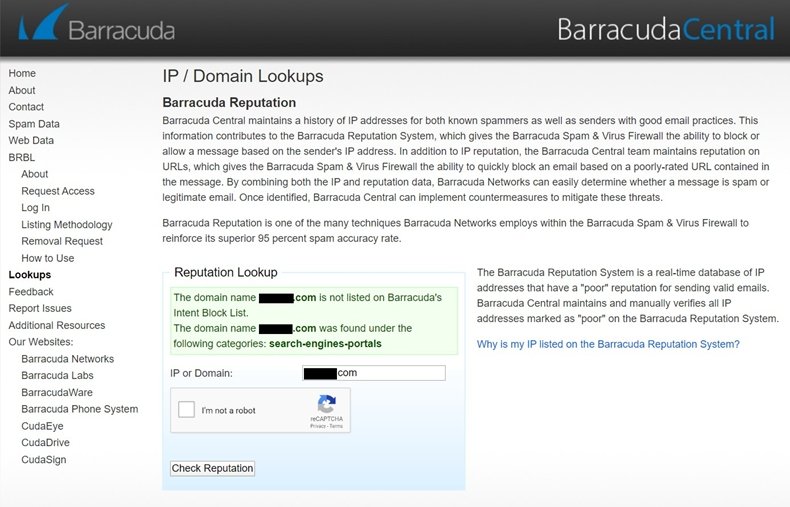
If you're looking for something a bit more in-depth, try Sender Score. The same idea applies: Just enter the IP of the sender you'd like to check and presto, your reputation comes to light. Sender Score is great for providing deeper info on whether your SPF and MX records are still valid and checking your SSL certificate expiration date and your sender scores for specific IPs along with their volume.
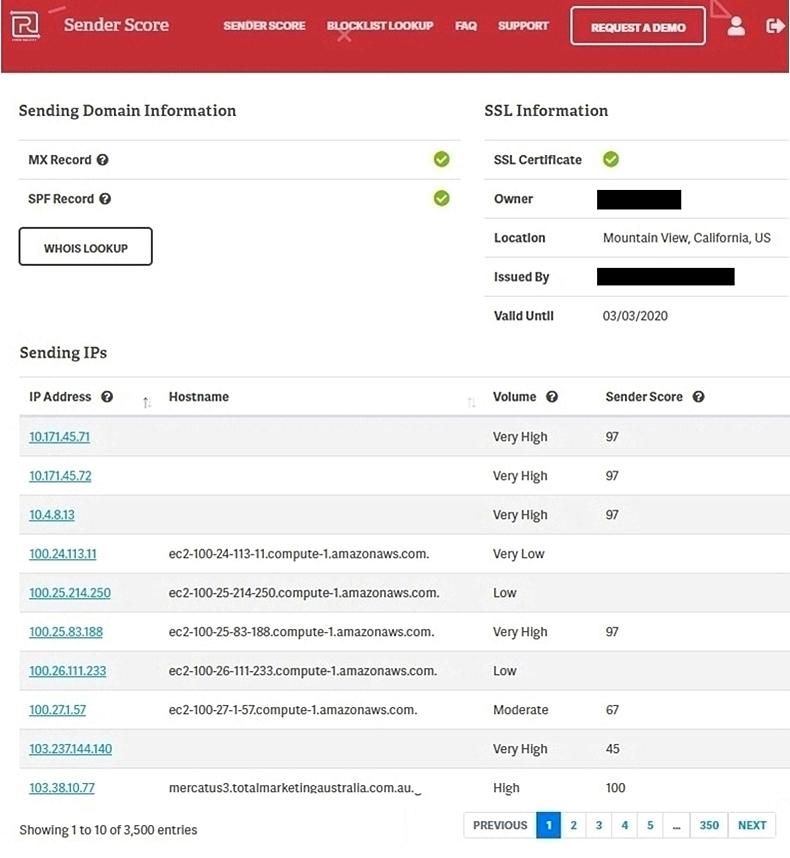
Reference Your Web Analytics
The first step to combating a spam bot problem is seeing whether you have one to begin with. One initial step to double-check whether those email performance metrics you're seeing are BS is to reference your Web analytics.
Connect with your website team to view specific stats from Google Analytics, Adobe Analytics, or other analytics tool for content you sent via email. Now, we all know email performance reports aren't perfect 100% of the time, but if GA is showing click metrics that are off by thousands of clicks, then obviously something is amiss.
What to do next?
Operation: Covert Landing Page
A "covert" landing page, as I like to affectionately call it, is pretty much exactly what it sounds like: a hidden landing page designed to track bots
A covert landing page can be set up as a dummy program in your MAS tool and added to different emails in an unseen, hidden spot where no real user would ever click on it.
Here I'll use Marketo for my personal example, but the same principles apply to other MAS tools as well.
After setting up the Operational program with a dummy landing page, next you can set up a Smart Campaign to track these covert clicks. Begin in the smart list by using a trigger filter for Clicks Link in Email > Email is any > Link is Covert Page and input your specific landing page link.

Follow that up in the Flow with a Change Program Status to Operational > Member and Add to List to keep track of these clicks at the program level and within a static list you can easily reference.
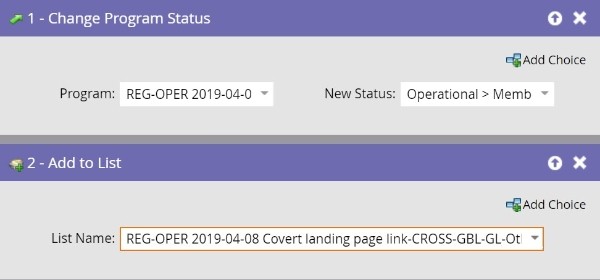
Now, you have a succinct program where you can see and continually track "who" is clicking on this covert link. You can drill down further to specific emails in additional smart lists within that program as well.
Custom UTMs
You can also create specific UTMs to track links from spam bots. Place a hidden link in an email somewhere, again so only a bot and not an actual person would be able to see and click it. Then create a smart list to see how many clicks the link with that UTM gets.
I've tried this method before as well by hiding a link in different email programs. Use UTMs to differentiate your hidden link like utm_term=covert at the end of the URL. Add these UTMs to a page someone would typically expect to see when viewing your email marketing, like your website homepage. That way, it won't seem jarring if by some miracle a real contact from your database went wildly clicking around your email and hit that link by accident.
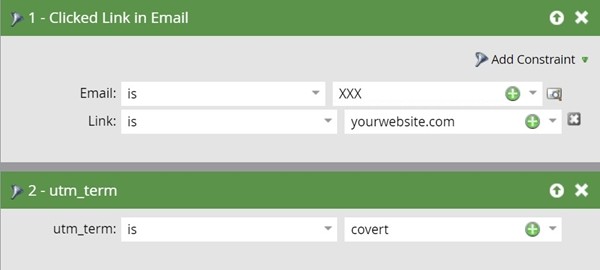
Lists, Lists, Lists
After implementing these covert links to your emails, identify these fake clickers through smart lists.
There are a few variations you can use: A smart list containing filters for Clicked Link in Email > Link Is Covert Link AND Clicked Link in Email > Is Not Covert Link. This option shows you how many people clicked on the hidden covert link and clicked on another link within your email. Though not perfect, this should pull a much smaller number of contacts you can investigate further to see whether they have other legitimate activity from your other email marketing.
I ran this smart list for a recent campaign and found interesting results. For a large, global send I saw over 700 leads who clicked on the covert link. Drilling down further, I found two of those leads also clicked on other links from our newsletter. After looking through their lead records, I noticed they were legitimate contacts who have interacted with other emails and downloaded gated pieces of content in the past.
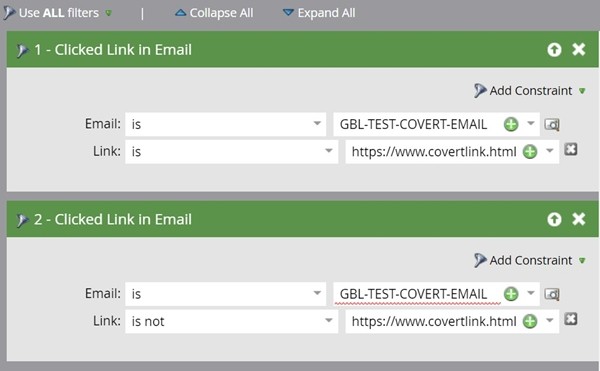
A similar option would be to check if anyone clicked on every link in your email. Bots may go through a whole email and click on every link as precautionary spam check. People aren't likely to click on every link in your email, especially if that includes a hidden link invisible to the naked eye. Someone who clicks on every link is a definite red flag.
Another smart list option to try is Clicked Link in *Specific* Email 1 > Link Is Covert Link AND Clicked Link in *Specific* Email 2... and so on, with however many emails you have the covert link placed in. If you see the same contacts continually clicking on the hidden link, that's a telltale sign you need to do some more investigating.
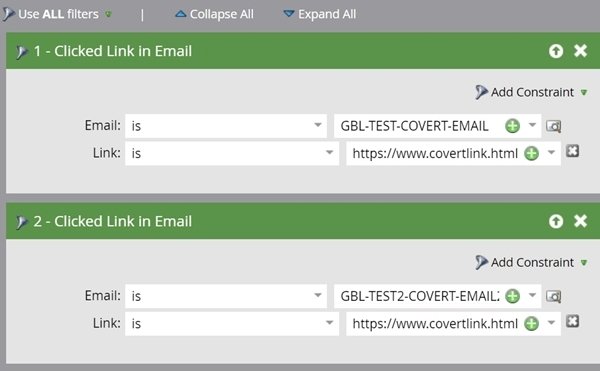
Even easier: if you have the covert link in several emails and don't want to add filter after filter into your smart list, instead check how many times the covert link has been clicked. Set up a similar filter for Clicked Link in Email > Email is Any > Link is Covert link > Min. Number of Times 2.

Next Steps
Now, after identifying whether you have a spam bot problem and pinpointing who are the culprits in your database, it's time to act.
Third-party vendors can help you drill down even more specifically and look at factors like contacts who were Delivered/Opened an email and Clicked the covert link at the exact same time. Assuming you can't access or get budget for these types of fancy tools, stick with your smart lists.
After using the smart lists to find these clicks, the next step is researching whether they are legitimate contacts. Look at the contacts in your lists and check their activity reports on a contact-by-contact basis. You can blacklist or suspend the ones you deem bots from receiving further communications and impacting your email performance.
This can be a grueling process, but it's worth it in the end if you can eliminate those inflated email performance reports.




